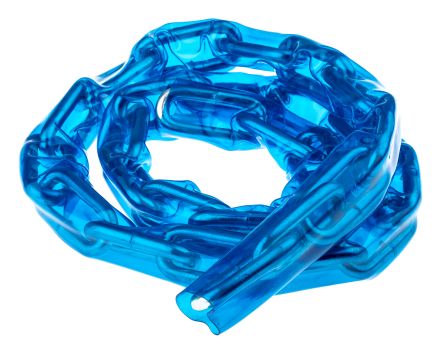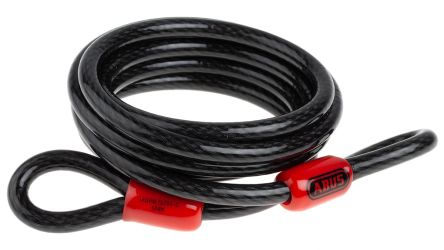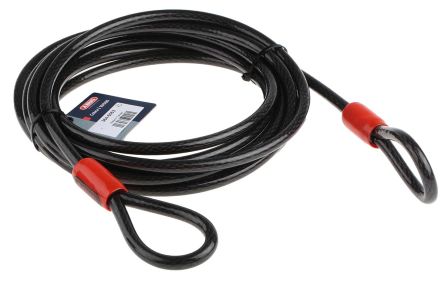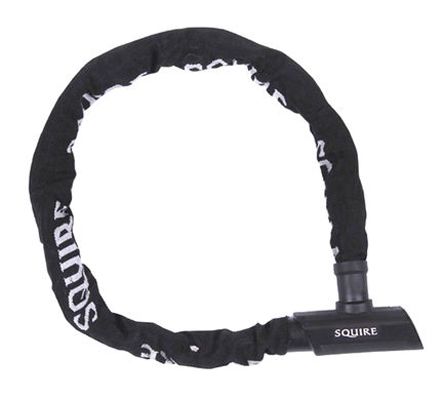
|
What are security cables?
|
Security cables and wires, steel rope chains and anchor points are all excellent ways of securing large and cumbersome items to immobilise them for both safety and protection. Whether used to tie important items to immovable structures and padlock them in place, or to secure expensive and potentially dangerous power tools into a racking, steel wire cables are a versatile anti-theft and safety solution. Ideal for all manner of home and workplace uses, stainless steel security cables are a tough, durable and reliable way to make sure important items stay exactly where you left them. In this guide, we’ll look more closely at some of the many applications of security cables and locking steel ropes, as well as some of the different types and sizes available on the market today. |

|
What are security cables used for?
Security cables and lockable stainless steel wires have practically unlimited uses across a very wide range of home, office and industrial environments. In this section, we’ll examine a few common applications before moving on to discuss some of the many types and grades of cable rope you might consider for specific tasks.
Security cables for laptops |
Security cables for computers |
|
Laptop cable locks and security wires are generally placed at the lighter gauge end of the steel locking cable spectrum - they need to be tough enough to prevent unauthorised removal of expensive portable electronics (not just laptops!), but not so heavy/industrial as to be impractical to carry around, or risk damage to smaller items of value. As laptops are most often secured while in use, locking wires of this type tend to be designed to attach quickly and easily either to the user themselves, or to whatever permanent or semi-permanent fixtures are available in the vicinity at the time. |
Desktop computer security cable locks are often somewhat sturdier than their laptop equivalents, as it’s generally assumed that a full PC on a desktop will rarely need to be moved (and will also be left unattended more often than most laptop computers or similar items). They usually anchor to a desk, wall or other heavy/bulky item of furniture that would make swift, unnoticed removal of the computer impractical for anyone without authorised access. |

|

|
Security cables for motorcycles |
Security cables for kayaks |
|
Motorcycle cable locks are one of the most common applications seen in everyday use in cities all over the world, and are generally built around a heavier-gauge stainless steel linked chain or braided cable for greater security. Motorbike cable locks and chains tend to be more rugged and highly resistant to unauthorised tampering than most thinner locking wires intended for personal electronics, Popular options for motorcycle security locks include a linked hardened steel chain with a PVC sheath that makes it ideal for outdoor applications. Alternatively, thicker gauges of braided stainless steel cable are often used which combine high tech steel alloys in a woven design. This variant of bike lock chain is especially resistant to cutting, and often features a simple loop design at one end for easy and quick securing of the vehicle to fences, gates, lamp posts and other permanent fixtures. |
Similar to motorbike chains, kayak security cables need to be sturdy and easily attached to vehicles, trailers and other heavy or permanent items when out and about. Kayak chains must also be fairly weatherproof, and highly resistant to cutting, unauthorised tampering or keyless release. Most kayak security cables feature an easy-to-affix lasso-type design, often with sturdy tamper-proof locks or security bars integrated into generous lengths of vinyl-coated galvanised steel rope. Plastic coatings on braided cables of this type serve a threefold purpose, protecting both the kayak and whatever it’s attached to, as well as safeguarding the user against abrasions and making sure the locking cable will perform in all weathers for an extended period. |

|

|
Types of steel security cables
Security cables and lockable stainless steel wires have practically unlimited uses across a very wide range of home, office and industrial environments. In this section, we’ll examine a few common applications before moving on to discuss some of the many types and grades of cable rope you might consider for specific tasks.
Security cables with locksA great many brands, gauges and types of high security stainless steel cables include an integrated locking mechanism, either via a master lock affixed to the looped ends of a braided steel cable, or using some sort of security bar-type fitting. Locks on security cables can often be opened with a physical key that’s kept separate from the wire chain itself, or just as commonly seen is the familiar combination-type lock that relies on a passcode being entered mechanically before the lock will release. A 3-digit lock of this latter type will have 1,000 possible combinations of three numbers, while the more common 4-digit varieties massively increase this to 10,000 different unique combinations. Locking cables sometimes incorporate alarms, fixed bars and other additional security features too, and the highly diverse selection of products in this category on the market today means you’re always likely to find the precise type of security cable to suit your needs. |
Braided steel security cablesBraided steel cable is prized for its flexibility and very sturdy resistance to both cutting and shearing forces. Braided wire security locks of this kind are very often designed to prevent leverage-style tempering as well. As braided metal cables would otherwise be quite abrasive to paintwork and surfaces if left uncovered, they tend to come coated in soft plastic, silicone or other rubberised materials to protect the items they’re securing and the user’s hands, as well as adding an extra layer of durability and weatherproofing. Braided cable, commonly known as wire rope, is generally made up of many separate steel strands woven together (and each of these is often constructed from multiple individual wires interwoven, too). When wrapped around a central core, this construction method tends to make braided steel cable just as sturdy, as a collective unit, as higher gauge single steel wires - not to mention much more flexible and far lower in overall weight. Braided cable is less prone to shearing and boasts very high tensile strength, although one potential disadvantage is that it can break more easily if enough of the individual strands are damaged or nicked. The flipside of this is that, unlike steel link chains which become immediately useless when a single link breaks, braided cables can still offer good physical strength and a deterrent to unauthorised tampering even if a few of its individual strands are compromised. |
Coated steel security cablesCoated steel cable - whether it’s coated braided wire or a heavier and less flexible link chain - is very common in all types of applications where the security cable will be left out in the elements or exposed to changing environmental conditions on a regular basis. Security cables intended for marine or outdoor use are almost always coated in some way, with the possible exception of very heavy-gauge link chains. Most coated braided steel cable is wrapped in some form of plastic or rubberised jacketing material - frequently this will be vinyl, PVC, nylon, HDPE or similar polymers, manufactured to provide both weatherproofing capabilities and protection to painted surfaces. Coatings also make security cables easier to handle and transport, and in some cases can offer an additional layer of tamper-proofing when made from sufficiently robust materials. |
Thin steel security cablesThin stainless steel cable - often braided - is most commonly found on laptop security wires and other locking mechanisms designed to secure and immobilise smaller items of value such as personal electronics and power tools. They’re usually designed to be lightweight and very flexible cables for easy transport and handling, while also offering fairly robust resistance to casual tampering, theft or movement. Thin cables of this sort can often be designed to attach to the user, rather than to a permanent immobile fixture or fitting, and so they’ll often incorporate built-in loops or wrist straps to make them more comfortable and convenient in day-to-day use. |
Flexible steel security cablesFlexibility is an important feature in most everyday steel security cables, which is why a great many of them incorporate a braided stainless steel wire design - this has the advantage of offering both flexibility and lightness while also providing impressive tensile and shear strength in a multitude of applications. Although flexibility is prized in security wire locks of this kind, it’s also important for ease of use that the design and manufacture of steel locking cables prevents easy twisting and tangling. Many leading brands and manufacturers will note that their products are designed from high flexibility but with lower tendency to twist or tangle. |
High carbon security cables‘High carbon’ steel cable refers to an elevated percentage of carbon used in the alloy. Higher carbon ratios in steel alloys generally make for a harder material, while mild steel has relatively lower tensile strength. Although the hardness of high-carbon steel can make it inherently more brittle and prone to fracture in some applications, braided high carbon steel cables and wires don’t suffer from this issue in the same way as sheet materials would. High carbon steel is still a very popular choice for extra-tough security cables and lockouts, being exceptionally strong with good all-round wear resistance in most cabling and lockable wire applications. |
What is the breaking strength of a steel security cable?
|
While it’s generally held that the breaking strength of braided steel cables isn’t technically any higher than that of a single-strand cable of the same thickness/area, the advantage of braided security cables is that they’re much more flexible and durable. If one or two strands of a braided cable are compromised, the load remains distributed among all the remaining strands, meaning the cable as a whole can often continue to be used - whereas any sort of failure in a single-strand cable is usually a catastrophic one. For any sort of steel wire or security cable, the breaking strength or load rating of the cable will be directly proportional to its overall diameter and the gauge of any individual strands forming the braid. Strength specifications will also be dependent on the type and manufacture of the cable’s core material, as well as the efficacy of any coatings or other materials incorporated into the design. |

|
Product spotlights
Click on the links below to browse our most popular security cables.



